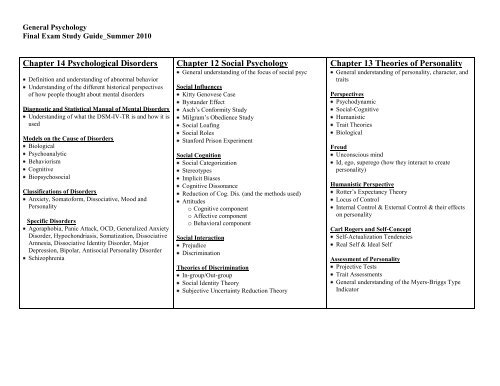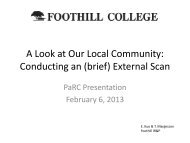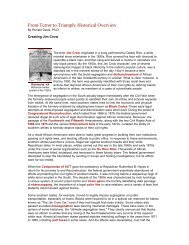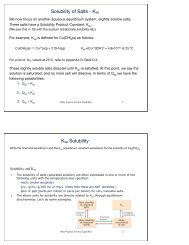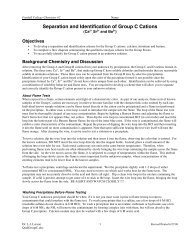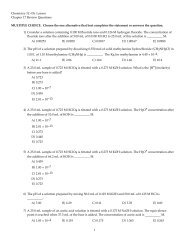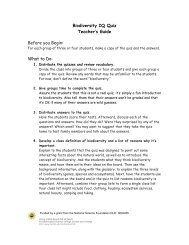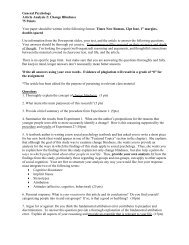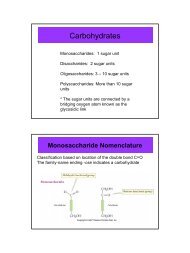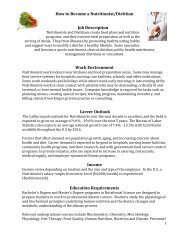Chapter 14 Psychological Disorders Chapter 12 Social Psychology ...
Chapter 14 Psychological Disorders Chapter 12 Social Psychology ...
Chapter 14 Psychological Disorders Chapter 12 Social Psychology ...
You also want an ePaper? Increase the reach of your titles
YUMPU automatically turns print PDFs into web optimized ePapers that Google loves.
General <strong>Psychology</strong><br />
Final Exam Study Guide_Summer 2010<br />
<strong>Chapter</strong> <strong>14</strong> <strong>Psychological</strong> <strong>Disorders</strong><br />
Definition and understanding of abnormal behavior<br />
Understanding of the different historical perspectives<br />
of how people thought about mental disorders<br />
Diagnostic and Statistical Manual of Mental <strong>Disorders</strong><br />
Understanding of what the DSM-IV-TR is and how it is<br />
used<br />
Models on the Cause of <strong>Disorders</strong><br />
Biological<br />
Psychoanalytic<br />
Behaviorism<br />
Cognitive<br />
Biopsychosocial<br />
Classifications of <strong>Disorders</strong><br />
Anxiety, Somatoform, Dissociative, Mood and<br />
Personality<br />
Specific <strong>Disorders</strong><br />
Agoraphobia, Panic Attack, OCD, Generalized Anxiety<br />
Disorder, Hypochondriasis, Somatization, Dissociative<br />
Amnesia, Dissociative Identity Disorder, Major<br />
Depression, Bipolar, Antisocial Personality Disorder<br />
Schizophrenia<br />
<strong>Chapter</strong> <strong>12</strong> <strong>Social</strong> <strong>Psychology</strong><br />
General understanding of the focus of social psyc<br />
<strong>Social</strong> Influences<br />
Kitty Genovese Case<br />
Bystander Effect<br />
Asch’s Conformity Study<br />
Milgram’s Obedience Study<br />
<strong>Social</strong> Loafing<br />
<strong>Social</strong> Roles<br />
Stanford Prison Experiment<br />
<strong>Social</strong> Cognition<br />
<strong>Social</strong> Categorization<br />
Stereotypes<br />
Implicit Biases<br />
Cognitive Dissonance<br />
Reduction of Cog. Dis. (and the methods used)<br />
Attitudes<br />
o Cognitive component<br />
o Affective component<br />
o Behavioral component<br />
<strong>Social</strong> Interaction<br />
Prejudice<br />
Discrimination<br />
Theories of Discrimination<br />
In-group/Out-group<br />
<strong>Social</strong> Identity Theory<br />
Subjective Uncertainty Reduction Theory<br />
<strong>Chapter</strong> 13 Theories of Personality<br />
General understanding of personality, character, and<br />
traits<br />
Perspectives<br />
Psychodynamic<br />
<strong>Social</strong>-Cognitive<br />
Humanistic<br />
Trait Theories<br />
Biological<br />
Freud<br />
Unconscious mind<br />
Id, ego, superego (how they interact to create<br />
personality)<br />
Humanistic Perspective<br />
Rotter’s Expectancy Theory<br />
Locus of Control<br />
Internal Control & External Control & their effects<br />
on personality<br />
Carl Rogers and Self-Concept<br />
Self-Actualization Tendencies<br />
Real Self & Ideal Self<br />
Assessment of Personality<br />
Projective Tests<br />
Trait Assessments<br />
General understanding of the Myers-Briggs Type<br />
Indicator
<strong>Chapter</strong> 9 Motivation and Emotion<br />
Motivation<br />
Definition<br />
Extrinsic & Intrinsic<br />
Amabile’s Creativity Experiment<br />
Dweck’s Self-Theory of Motivation<br />
Effects of praise of intelligence and praise of effort<br />
and the ramifications (from PPT)<br />
Maslow’s Hierarchy of Needs<br />
Big picture understanding of the theory<br />
Physiology of Emotions<br />
Role of the Amygdala<br />
Whalen et al. (2001) Study<br />
Behavior of Emotions<br />
Connection between emotion and facial expressions<br />
Ekman & Friesen (1971)’s Study of Universal<br />
Expressions<br />
Subjective Experience: Labeling Emotions<br />
General understanding of research findings (from text)<br />
<strong>Chapter</strong> 10 Gender and Sexuality<br />
Gender<br />
Gender, sex, gender identity, gender role<br />
Gender Differences (as discussed on the PPT)<br />
Cognitive Differences<br />
Communication Differences<br />
<strong>Social</strong>ization<br />
Environmental & Cultural Influences<br />
<strong>Social</strong> Learning Theory<br />
Gender Schema Theory<br />
Male & Female Brain (as discussed on the PPT)<br />
Structural & Functional Differences<br />
Reasons for Differences<br />
Gender Variations<br />
Androgyny<br />
Transgender<br />
Intersex<br />
Researchers<br />
Kinsey: General Understanding of his contributions to the<br />
field of human sexuality<br />
Master’s and Johnson’s “Observational Study”<br />
Sexual Self-Schema<br />
Definition and understanding of it in relation to the self and<br />
behavior


